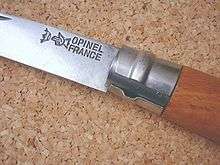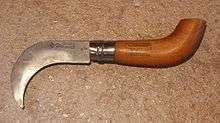Opinel knife
Opinel is a company that has manufactured and marketed a line of self-named wooden-handled knives since 1890 from its headquarters in Saint-Jean-de-Maurienne, Savoie, France—where the family-run company also operates a museum dedicated to its knives. The company sells approximately 15 million knives annually. The Opinel knives are all made of highest quality Sandvik steel from Sweden. The knives are avaliable in high carbon steel and stainless steel. Opinel knives are also famous for being able to float in water.
Originally sold as a working man's knife, an Opinel knife has become emblematic of French culture, [1] with Pablo Picasso reportedly using one of the company's knives as a sculpting tool.[1] In 1989, the Larousse dictionary cited "Opinel" as a registered trademark—and in the French language, the term "Opinel" has become a genericized trademark to refer to any wood handled pocket or penknife, not necessarily only those made by the company.

History
Joseph Opinel began making knives in 1890 in Savoie, France as a simple working man's or peasant's knife.[2][3][1] It proved popular with the local farmers, herdsmen, and paysans-vignerons (peasant winemakers) of the area.[1][4][5] In 1897, a series of twelve sizes, numbered 1 to 12, was developed.[6] From 1901–1903, Joseph Opinel built his first factory in Pont de Gévoudaz and produced a machine for mass production of the knife's wooden handles.[6]
The company hired peddlers to sell the knives and opened a small shop near the Chambéry railway junction, where the knives became popular with PLM railroad workers, who in turn spread word of the brand throughout France.[1][7] By 1909, Opinel had registered his first trademark for the Opinel knife, choosing the main couronnée ('crowned hand") as his emblem.[6] A few years later Opinel annual sales were in the hundreds of thousands, and by the start of World War II as many as 20 million knives had been sold.[8]
The Opinel Virobloc or safety twistlock mechanism was invented by Marcel Opinel in 1955, increasing the safety and versatility of the knife by allowing the blade to be locked in the open position.[1][6] In 2000, the Virobloc locking mechanism was improved to allow locking the blade in either the open or closed position.[1][6]
In 1985 the Victoria and Albert Museum in London selected the Opinel as part of an exhibit celebrating the “100 most beautiful products in the world”, featuring the Opinel alongside the Porsche 911 sports car and the Rolex watch.[1] The Opinel was also selected as one of the 999 classic designs in Phaidon Design Classics,[1][6] and has been exhibited by the New York's Museum of Modern Art (MOMA) as a design masterpiece.[1]
Description
Materials
The traditional Opinel knife has a beechwood handle and a high carbon XC90 steel (acier au carbone) blade. Opinel also offers most of its models with a Sandvik 12C27M stainless steel (acier inox) blade.[9] Custom Opinel models are available using luxurious or exotic handle woods such as oak, walnut, olive, rosewood and stained hornbeam, as well as other materials such as cowhorn.
The Opinel Slim Effile series uses a tapered handle with a slender clip point blade made of Sandvik stainless steel, and the handle may be obtained in a variety of different materials, including bubinga wood, olive wood, and cowhorn.
Construction



The current Opinel knife consists of a blade, wooden handle, stainless steel metal clamping band, stainless pivot pin (axle), and (except in the case of the smaller models) a stainless steel Virobloc locking collar, which locks the blade open or closed.
Smaller Opinel models (Nos. 2 through 5) have no locking blade mechanism, and use only the friction of the clamping band against the compressed handle and knife tang to hold the blade open, much the same as all Opinel knives sold before 1955. This simple design was sometimes known as a "penny knife" or "peasant's knife".
The locking collar(Virobloc) was patented in 1955 by Marcel Opinel, and is only found on the larger Opinel models (#6 and up).[1][6] While simple, the locking mechanism is quite sturdy, and converts the folding Opinel knife into nearly the equivalent of a fixed-blade knife for all practical purposes.[10] Due to the way in which the locking collar tapers, the blade does not loosen over time and can be fixed firmly even once the mechanism is quite worn. In 2000 the locking collar was modified slightly to allow the blade to be locked in the closed as well as the open position.[1][6] This feature prevents the blade from opening by accident when carried in a pocket.[1][6][11]
Eighty percent of all Opinel knives use traditional beechwood for the handle.[7] The company's large demand for beechwood not infrequently results in a shortage of precut handle blanks, forcing the use of rectangular (bulk) sheets, which generate considerable wood waste. The excess wood waste and sawdust generated is subsequently recycled.[7]
Design and operation
The curve of the original Opinel blade is a Yatagan, while the flared butt at the base of the wood handle is referred to as a fishtail. The No. 8 Couteau du Jardin or Garden Knife uses a folding drop-point blade in concert with a slim, tapered wood handle, while the Opinel No. 8 and No. 10 Pruning Knives, designed for pruning shrubs and vines, feature a large folding hawkbill blade fitted to an elegantly curved wooden handle. The Opinel Slim Effile series use a thinner-profile stainless steel blade fitted to a tapered wood handle. Available in several sizes and handle materials, the Slim Effile series knives are intended for tasks such as cleaning and fileting fish and thinly slicing meats and cheeses.
The traditional Opinel is designed to be opened with two hands, and a nail nick is provided on the blade.[12] It is possible to adjust the fitting of the safety locking collar in the event that the latter is either too tight or too loose.[12] Those practiced in the art often utilize the coup du savoyard—tap the heel of the handle hard on the table once and the blade should open slightly from the handle, allowing it to be rotated into position with the thumb.[12]
Logo

The main couronnée ("crowned hand") device was already present on the blade of very early models. Later the words OPINEL and FRANCE were added, as well as INOX ("stainless", from "INOXidable", meaning "non-oxidizable) in the case of stainless steel blades.
The image of the hand comes from the arms of Saint-Jean-de-Maurienne, and represents the relics of John the Baptist, three of whose finger-bones were supposedly brought back from Alexandria by Saint Tecla in the 5th century. The crown comes from the arms of Savoy, the larger region containing Savoie.
Sizes and variations
Opinel knives are currently offered in eleven numbered sizes: 2, 3, 4, 5, 6, 7, 8, 9, 10, 12, and 13. The No. 1 Opinel was discontinued in 1932.[13] With its tiny 2 cm (0.787-inch) blade and boxwood handle, it was meant to be attached to a key fob or watch chain and used as a tobacco pipe cleaner[13][14] or nail cleaner,[14] but was judged to be too small.[13] The No. 11 Opinel was discontinued in 1935, its size being considered too similar to Opinels Nos. 10 and 12.[13]
With its 8.5 cm blade, the No. 8 Opinel is perhaps the most widely used size, though Nos. 4, 6, and 10 are consistent sellers. There is a considerable difference in size between No. 12 (12 cm blade) and the recently-added novelty No. 13, Le Géant ("the Giant") with its 22 cm blade. There is now a No. 7 round-ended knife without the sharp point, intended for children and others as "My first Opinel".
A variety of different Opinels have been offered over the years. A few are sold more for their novelty value than for practical purposes, such as Le Géant. Besides the Slim Effile series and the Couteau du Jardin, Opinel also offers a hawkbill-bladed pruning knife designed for use in the garden or vineyard, and a large folding wood saw with locking blade using the same Virobloc mechanism as found on large Opinel knives. For the kitchen, the company sells vegetable peelers, chefs knives, paring knives, knives with corkscrews (couteau tire-bouchon), and prep knives for the kitchen, including a mushroom knife (couteau à champignon), with an integral boar's hair cleaning brush.[13]
References
- 1 2 3 4 5 6 7 8 9 10 11 12 13 (2007),Couteau Opinel, Une lame universelle, Directsoir N°233, 30 October 2007
- ↑ Musée de l'Opinel: Bienvenue, retrieved 5 July 2011
- ↑ Opinel, Savoie's Famous Knife, Serveur Savoie
- ↑ Musée de l'Opinel: Bienvenue, retrieved 5 July 2011
- ↑ Opinel, Savoie's Famous Knife, Serveur Savoie
- 1 2 3 4 5 6 7 8 9 Opinel History, Opinel USA, retrieved 4 July 2011
- 1 2 3 Serraz, Gabrielle, (2009), Opinel: plus qu’un couteau, un objet culte Les Echoes, 8 July 2009
- ↑ Opinel in the World, Musee De L'Opinel, retrieved 4 July 2011
- ↑ Opinel Carbon vs. Stainless Blades, OpiKnife.com, retrieved 5 July 2011
- ↑ (2006),Opinel Folders, Outdoors-Magazine.com, 19 September 2006 (revised)
- ↑ Coutellerie: couteaux-fermants, Opinel, UNIFRANCE.fr (2007): La bague double sécurité Virobloc® permet de bloquer la lame en position ouverte pour empêcher qu'elle se referme et, en position fermée, pour empêcher qu'elle s'ouvre en poche.
- 1 2 3 (2011), Smooth functioning, Musée de l'Opinel, retrieved 5 July 2011
- 1 2 3 4 5 (2009), Chahi, C.L’Opinel, un design intemporel, maisonapart.com, 26 June 2009
- 1 2 Le Grand Robert & Collins French-English Dictionary, édition 2008-2009, Vol. 1, Harper-Collins Publishers Ltd., ISBN 2-84902-412-0, ISBN 978-2-84902-412-6 (2009): cure-pipe, nm - pipe cleaner; cure-ongles, nm = nail cleaner
See also
External links
| Wikimedia Commons has media related to Opinel. |